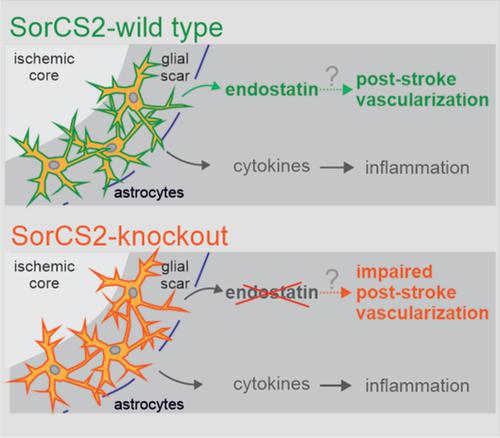Our official English website, www.x-mol.net, welcomes your
feedback! (Note: you will need to create a separate account there.)
SorCS2 facilitates release of endostatin from astrocytes and controls post-stroke angiogenesis.
Glia ( IF 5.4 ) Pub Date : 2020-01-03 , DOI: 10.1002/glia.23778 Anna R Malik 1, 2 , Janet Lips 3, 4, 5 , Malgorzata Gorniak-Walas 1 , Diede W M Broekaart 6 , Antonino Asaro 1 , Melanie T C Kuffner 3, 4 , Christian J Hoffmann 3, 4 , Majed Kikhia 3, 4, 7 , Monika Dopatka 3, 4 , Philipp Boehm-Sturm 3, 4, 8 , Susanne Mueller 3, 4, 8 , Ulrich Dirnagl 3, 4, 5, 7, 9 , Eleonora Aronica 6, 10 , Christoph Harms 3, 4, 5, 7 , Thomas E Willnow 1
Glia ( IF 5.4 ) Pub Date : 2020-01-03 , DOI: 10.1002/glia.23778 Anna R Malik 1, 2 , Janet Lips 3, 4, 5 , Malgorzata Gorniak-Walas 1 , Diede W M Broekaart 6 , Antonino Asaro 1 , Melanie T C Kuffner 3, 4 , Christian J Hoffmann 3, 4 , Majed Kikhia 3, 4, 7 , Monika Dopatka 3, 4 , Philipp Boehm-Sturm 3, 4, 8 , Susanne Mueller 3, 4, 8 , Ulrich Dirnagl 3, 4, 5, 7, 9 , Eleonora Aronica 6, 10 , Christoph Harms 3, 4, 5, 7 , Thomas E Willnow 1
Affiliation

|
SorCS2 is an intracellular sorting receptor of the VPS10P domain receptor gene family recently implicated in oxidative stress response. Here, we interrogated the relevance of stress-related activities of SorCS2 in the brain by exploring its role in ischemic stroke in mouse models and in patients. Although primarily seen in neurons in the healthy brain, expression of SorCS2 was massively induced in astrocytes surrounding the ischemic core in mice following stroke. Post-stroke induction was likely a result of increased levels of transforming growth factor β1 in damaged brain tissue, inducing Sorcs2 gene transcription in astrocytes but not neurons. Induced astrocytic expression of SorCS2 was also seen in stroke patients, substantiating the clinical relevance of this observation. In astrocytes in vitro and in the mouse brain in vivo, SorCS2 specifically controlled release of endostatin, a factor linked to post-stroke angiogenesis. The ability of astrocytes to release endostatin acutely after stroke was lost in mice deficient for SorCS2, resulting in a blunted endostatin response which coincided with impaired vascularization of the ischemic brain. Our findings identified activated astrocytes as a source for endostatin in modulation of post-stroke angiogenesis, and the importance of the sorting receptor SorCS2 in this brain stress response.
中文翻译:

SorCS2 促进星形胶质细胞内皮抑素的释放并控制中风后血管生成。
SorCS2 是 VPS10P 域受体基因家族的细胞内分选受体,最近与氧化应激反应有关。在这里,我们通过探索 SorCS2 在小鼠模型和患者中的缺血性中风中的作用,询问了大脑中 SorCS2 的压力相关活动的相关性。尽管主要见于健康大脑的神经元中,但在中风后小鼠缺血核心周围的星形胶质细胞中大量诱导了 SorCS2 的表达。中风后诱导可能是受损脑组织中转化生长因子 β1 水平增加的结果,诱导星形胶质细胞而非神经元中的 Sorcs2 基因转录。在中风患者中也观察到了 SorCS2 的星形胶质细胞表达,证实了这一观察结果的临床相关性。在体外星形胶质细胞和体内小鼠脑中,SorCS2 专门控制内皮抑素的释放,这是一种与中风后血管生成有关的因素。在缺乏 SorCS2 的小鼠中,星形胶质细胞在中风后迅速释放内皮抑素的能力丧失,导致内皮抑素反应迟钝,这与缺血脑的血管化受损相吻合。我们的研究结果确定活化的星形胶质细胞是调节中风后血管生成中内皮抑素的来源,以及分选受体 SorCS2 在这种脑应激反应中的重要性。
更新日期:2020-01-03
中文翻译:

SorCS2 促进星形胶质细胞内皮抑素的释放并控制中风后血管生成。
SorCS2 是 VPS10P 域受体基因家族的细胞内分选受体,最近与氧化应激反应有关。在这里,我们通过探索 SorCS2 在小鼠模型和患者中的缺血性中风中的作用,询问了大脑中 SorCS2 的压力相关活动的相关性。尽管主要见于健康大脑的神经元中,但在中风后小鼠缺血核心周围的星形胶质细胞中大量诱导了 SorCS2 的表达。中风后诱导可能是受损脑组织中转化生长因子 β1 水平增加的结果,诱导星形胶质细胞而非神经元中的 Sorcs2 基因转录。在中风患者中也观察到了 SorCS2 的星形胶质细胞表达,证实了这一观察结果的临床相关性。在体外星形胶质细胞和体内小鼠脑中,SorCS2 专门控制内皮抑素的释放,这是一种与中风后血管生成有关的因素。在缺乏 SorCS2 的小鼠中,星形胶质细胞在中风后迅速释放内皮抑素的能力丧失,导致内皮抑素反应迟钝,这与缺血脑的血管化受损相吻合。我们的研究结果确定活化的星形胶质细胞是调节中风后血管生成中内皮抑素的来源,以及分选受体 SorCS2 在这种脑应激反应中的重要性。











































 京公网安备 11010802027423号
京公网安备 11010802027423号